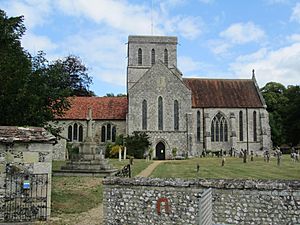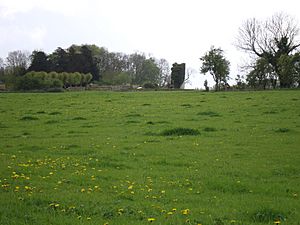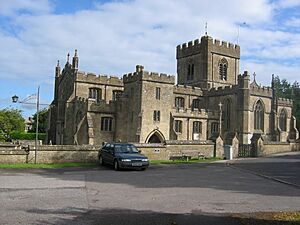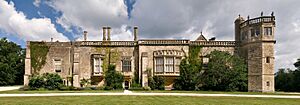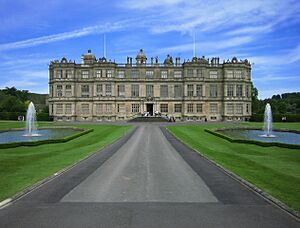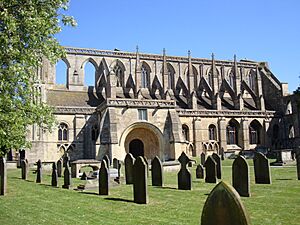List of monastic houses in Wiltshire facts for kids
This article lists the monastic houses that once existed in Wiltshire, England. Monastic houses were special places where groups of people, like monks or nuns, lived together. They followed strict religious rules and dedicated their lives to prayer and work. These communities played a big role in medieval society, often serving as centers for learning, healthcare, and charity.
There were different types of monastic houses:
- Abbeys were large communities led by an abbot (for monks) or an abbess (for nuns).
- Priories were smaller communities, often led by a prior or prioress. Some priories were also "alien houses," meaning they were controlled by a larger monastery in another country, like France.
- Friaries were homes for friars, who were like monks but often lived among people in towns to preach and help the poor.
- Preceptories were centers for military-religious orders, like the Knights Templar or Knights Hospitaller.
Many of these houses were closed down in the 1530s during the "Dissolution of the Monasteries" by King Henry VIII. This was a major event in English history.
Discover Monastic Houses in Wiltshire
This section explores the various monastic houses that were once active in Wiltshire. Each entry tells you about the type of community, when it was founded, and what happened to it.
| Name | Image | Community and History | Formal Name or Other Names |
|---|---|---|---|
| Amesbury Abbey | This abbey was home to Benedictine nuns. It was first founded around 979. Later, in 1177, it was refounded with nuns from Fontevrault in France. It became independent from France after 1403. The abbey was closed in 1539. | Abbey of St Mary and St Melor
Amesbury Priory |
|
| Ansty Preceptory | This was a home for the Knights Hospitaller, a military-religious order. It was founded around 1220. The preceptory was closed in 1540. Parts of it might be in the farmhouse at Manor Farm today. | ||
| Avebury Priory | This priory housed Benedictine monks and was an "alien house," meaning it depended on a monastery in France. It was founded after 1114 and closed in 1378. Avebury Manor was built on its site around 1557. | ||
| Bradenstoke Priory | This priory was for Augustinian Canons Regular. It was founded around 1139. The priory was closed on January 17, 1539. Some parts of it can still be seen within a farmstead called 'Bradenstoke Abbey'. | Clack Priory | |
| Bradford-on-Avon Monastery | This monastery was likely for Benedictine monks. It was founded around 705–710 by St Aldhelm. The building was used as a dwelling and a school later on. It was restored in 1870 and is now owned by the Wiltshire Archaeological Society. | St Lawrence | |
| Briontune Priory | This priory was for Augustinian Canons Regular. | St Mary Magdalene
Brioptune Priory |
|
| Britford Monastery | This was a possible early Saxon community. | ||
| Bromham Monastery | The type of religious order and when it was founded are not clear. | ||
| Calne Monastery | This was a possible early Saxon community. | ||
| Charlton Priory | This priory was for Premonstratensian Canons. It was an "alien house" dependent on a monastery in Normandy, France. It was founded around 1187 and closed in 1380. | Charleton Priory | |
| Clatford Priory | This priory housed Benedictine monks and was an "alien house" linked to a French monastery. It was founded after 1104. The priory was closed around 1439. | Clatford and Hullavington Priory | |
| Corsham Priory | This site might have been an early Saxon minster. It became an "alien house" for Benedictine monks, dependent on Marmoutier in France, founded before 1077. It stopped being a priory in 1294. | Cosham Priory | |
| Cricklade Monastery | This was a possible Saxon community of monks or secular clergy. | St Sampson | |
| Easton Priory or Hospital, Easton Royal | This was a Trinitarian hostel founded in 1245, later becoming a priory in 1251. It was damaged by fire in 1493 and was in ruins by the time it was closed in 1536. The current parish church might be on its site. |
Eston Friary |
|
| Edington Priory | The land was given to nuns in Romsey between 959 and 975. The current church was built in 1351. It became a priory for Bonshommes brothers in 1358. It was closed in 1539. The church is now used as All Saints' parish church. | St Mary, St Catherine and All Saints
All Saints' Church Edindon Priory |
|
| Fisherton Anger Friary | This was a home for Dominican Friars. The community moved here in 1281 from Fugglestone. It was closed in 1538. | ||
| Fugglestone Priory | This was the original home for Dominican Friars, founded in 1245. They moved to Fisherton Anger in 1281. The priory was closed in 1538. | ||
| Great Bedwyn Monastery | This was an apparent Saxon minster community in the 10th century. The current parish church of St Mary might be on or near its site. | St Lawrence | |
| Hullavington Grange | This was a grange (a farm or estate) for Benedictine monks, founded in 1104. It was closed after 1325. | ||
| Ivychurch Priory | This priory was for Augustinian Canons Regular. It was founded before 1154 by King Stephen. The priory was closed in 1536. | The Blessed Virgin Mary | |
| Kington St Michael Priory | This priory was for Benedictine nuns. It was founded before 1155. The priory was closed in 1536. The site is now part of a farm. | The Priory Church of St Mary, Kington St Michael
Keinton Priory |
|
| Lacock Abbey | This abbey was for Augustinian Canonesses. It was founded as a priory between 1230-1232 and became an abbey in 1239-1240. It was closed on January 21, 1539. Today, it is managed by the National Trust. | The Abbey Church of the Blessed Virgin Mary and Saint Bernard, Lacock | |
| Longleat Priory | This priory was for Augustinian Canons Regular. It was founded before 1233 and closed in 1529. The famous country house, 'Longleat House', was built on its site. | ||
| Loxwell Abbey | This was a home for Cistercian monks. It was founded in 1151 but closed in 1154 when the community moved to Stanley Abbey. | ||
| Maiden Bradley Priory | Originally a hospital for leper women, it became a priory for Augustinian Canons Regular around 1184. It was closed in 1536. | The Hospital and Priory Church of the Blessed Virgin Mary and Saint Lazarus, Maiden Bradley
Mayden Bradeley Priory |
|
| Malmesbury Abbey | This abbey has a long history, possibly dating back to before 603 with British nuns. It later housed Benedictine monks. It was destroyed by the Danes in 1010 but rebuilt. The abbey was closed on December 15, 1539. The church is still used today as a parish church. | Our Saviour, Saint Peter and Saint Paul, Malmesbury (after 675)
St Mary, Virgin (before 1143) |
|
| Marlborough Priory | This priory was for Gilbertine canons. It was possibly founded before 1189. It was plundered and partly destroyed by fire in 1337. The priory was closed in January 1539. | The Priory Church of Saint Margaret, Marlborough
Marleburgh Abbey |
|
| Marlborough Whitefriars | This was a home for Carmelite Friars, also known as Whitefriars. It was founded around 1316. The friary was in poor condition when it was closed in 1538 and was demolished in 1820. | Marleburgh Whitefriars | |
| Monkton Farleigh Priory | This priory was for Cluniac monks and was an "alien house" dependent on Lewes Priory. It was founded between 1120-1123. It became independent around 1373-1374 and was closed in 1536. Remains of the priory are part of a house built on the site. | St Mary Magdalene
Farleigh Priory |
|
| Netheravon Monastery | There is evidence suggesting a monastic community existed here before the Norman Conquest. | ||
| Ogbourne Priory | This priory was for Benedictine monks and was an "alien house" dependent on Bec Abbey in France. It was founded before 1147 and closed in 1414. Its possessions were later given to colleges and other religious houses. | Ogbourne Saint George Priory | |
| Rockley Preceptory | This preceptory was first for the Knights Templar, founded in 1155-1156. It was closed between 1308-1312. Later, it became a property of the Knights Hospitaller and was closed in 1541. | Temple Rockley Preceptory | |
| Salisbury Blackfriars | This was a home for Dominican Friars. The community moved here in 1281 from Wilton. The friary was closed in 1538. | ||
| Salisbury Greyfriars | This was a home for Franciscan Friars Minor, also known as Greyfriars. It was founded before 1230 and closed in 1538. | ||
| Stanley Abbey | This abbey was for Cistercian monks. The community moved here in 1154 from Loxwell Abbey. Much of the abbey was rebuilt in the 13th century. It was closed in 1536. | Stanlegh Abbey | |
| Stratton St Margaret Priory | This priory was for Benedictine monks and was an "alien house." It was later given to King's College, Cambridge. | ||
| Tisbury Monastery | This was a Saxon monastery, possibly for Benedictine monks, founded before 710. It was closed after 759. The current parish church of St John the Baptist might stand on its site. | ||
| Tisbury Grange | This was a grange (a farm or estate) for Benedictine nuns, dependent on Shaftesbury Abbey. Place Farm now occupies the site. | ||
| Upavon Priory | This priory was for Benedictine monks and was an "alien house" dependent on St-Wandrille in France. It was founded before 1086 and closed before 1414. | Uphaven Priory | |
| Wilton Abbey | This abbey was for Benedictine nuns. It has a very old history, possibly founded around 830. It was destroyed by the Danes in 1003 but later rebuilt. The abbey was closed on March 25, 1539. The famous 'Wilton House' was built on its site. | St Mary and St Bartholomew
St Mary, St Bartholomew and St Edith (after 987) |
|
| Wilton Blackfriars | This was a home for Dominican Friars, founded in 1245. The community moved to Salisbury in 1281. |
See also


